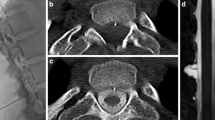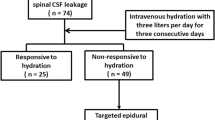Abstract
Objective
To evaluate patient outcomes following fluoroscopy-guided epidural blood patch (FGEBP), factors affecting the outcome, and to identify the rate of fluoroscopy-guided lumbar punctures (FGLP) requiring FGEBP.
Methods
All FGLPs and FGEBPs between January 2014 and May 2017 were retrospectively evaluated. Information regarding patient characteristics, details of previous dural puncture (DP), details of the FGEBP, and FGEBP outcome were recorded. The outcome was classified into three categories as “complete response”, “partial response”, and “no response”. Patients with “complete response” were compared to the combined group of “no response” and “partial response”, classified as “incomplete response”. Two-sample/Fisher’s exact (continued/categorical variables) tests were used (p < 0.05).
Results
Sity-seven FGEBPs were performed in 63 patients (female/male, 36/27; mean age/BMI 38/28.2). Fifty-nine were referred following DP; 31 were performed by radiologists. The rate of FGLPs requiring FGEBP was 1.78% within 3.5 years. The mean DP-FGEBP interval was 4.8 days. “Complete response” was achieved in 56 (84.8%), “no response” was found following 4 (6%) procedures. Average applied blood volume was 16 cc (5–30 cc). No difference was found between “complete response” and “incomplete response” groups regarding age, sex, BMI, DP performer, DP level, DP fluoroscopy time, DP needle caliber/type, FGEBP level, FGEBP needle caliber/type, FGEBP fluoroscopy time, FGEBP performer, and applied blood volume (p > 0.05). Despite approaching significance, no statistically significant difference was found regarding the presence of previous DP (p = 0.06).
Conclusions
The efficacy of FGEBP is high in a group of patients referred to radiology for treatment of CSF leakage with complete response in 84.8% of patients.
Key Points
• Fluoroscopy-guided epidural blood patch completely resolved symptoms in 85% of post-dural puncture headaches.
• The success approaches 95% when including the patients with partial resolution of symptoms.
• Epidural blood patch rate is found 1.8% following 1703 fluoroscopy-guided lumbar punctures.



Similar content being viewed by others
Abbreviations
- BMI:
-
Body mass index
- CSF-OP:
-
CSF opening pressure
- DP:
-
Dural puncture
- EBP:
-
Epidural blood patch
- FGEBP:
-
Fluoroscopy-guided epidural blood patch
- FGLP:
-
Fluoroscopy-guided lumbar puncture
- ICH:
-
Intracranial hypotension
- LP:
-
Lumbar puncture
- PDPH:
-
Post-dural puncture headache
- sICH:
-
Spontaneous intracranial hypotension
References
Evans RW, Armon C, Frohman EM, Goodin DS (2000) Assessment: prevention of post-lumbar puncture headaches: report of the Therapeutics and Technology Assessment Subcommittee of the American Academy Of Neurology. Neurology 55:909–914
Ahmed SV, Jayawarna C, Jude E (2006) Post lumbar puncture headache: diagnosis and management. Postgrad Med J 82:713–716
Yilmazlar S, Arslan E, Kocaeli H et al (2006) Cerebrospinal fluid leakage complicating skull base fractures: analysis of 81 cases. Neurosurg Rev 29:64–71
Kranz PG, Malinzak MD, Amrhein TJ, Gray L (2017) Update on the diagnosis and treatment of spontaneous intracranial hypotension. Curr Pain Headache Rep. https://doi.org/10.1007/s11916-017-0639-3
Amrhein TJ, Befera NT, Gray L, Kranz PG (2016) CT fluoroscopy-guided blood patching of ventral CSF leaks by direct needle placement in the ventral epidural space using a transforaminal approach. AJNR Am J Neuroradiol 37:1951–1956
Clark MS, Diehn FE, Verdoorn JT et al (2018) Prevalence of hyperdense paraspinal vein sign in patients with spontaneous intracranial hypotension without dural CSF leak on standard CT myelography. Diagn Interv Radiol 24:54–59
Turnbull DK, Shepherd DB (2003) Post-dural puncture headache: pathogenesis, prevention and treatment. Br J Anaesth 91:718–729
Booth JL, Pan PH, Thomas JA, Harris LC, D’Angelo R (2017) A retrospective review of an epidural blood patch database: the incidence of epidural blood patch associated with obstetric neuraxial anesthetic techniques and the effect of blood volume on efficacy. Int J Obstet Anesth 29:10–17
Berroir S, Loisel B, Ducros A et al (2004) Early epidural blood patch in spontaneous intracranial hypotension. Neurology 63:1950–1951
Sencakova D, Mokri B, McClelland RL (2001) The efficacy of epidural blood patch in spontaneous CSF leaks. Neurology 57:1921–1923
Paech MJ, Doherty DA, Christmas T, Wong CA, Epidural Blood Patch Trial G (2011) The volume of blood for epidural blood patch in obstetrics: a randomized, blinded clinical trial. Anesth Analg 113:126–133
Cho KI, Moon HS, Jeon HJ, Park K, Kong DS (2011) Spontaneous intracranial hypotension: efficacy of radiologic targeting vs blind blood patch. Neurology 76:1139–1144
Watanabe K, Hashizume K, Kawaguchi M, Fujiwara A, Sasaoka N, Furuya H (2011) Fluoroscopically guided epidural blood patch with subsequent spinal CT scans in the treatment of spontaneous cerebrospinal fluid hypovolemia. J Neurosurg 114:1731–1735
Bendel MA, Moeschler SM, Qu W et al (2016) Treatment of refractory postdural puncture headache after intrathecal drug delivery system implantation with epidural blood patch procedures: a 20-year experience. Pain Res Treat. https://doi.org/10.1155/2016/2134959
Friedman DI, Jacobson DM (2002) Diagnostic criteria for idiopathic intracranial hypertension. Neurology 59:1492–1495
van Kooten F, Oedit R, Bakker SL, Dippel DW (2008) Epidural blood patch in post dural puncture headache: a randomised, observer-blind, controlled clinical trial. J Neurol Neurosurg Psychiatry 79:553–558
Williams EJ, Beaulieu P, Fawcett WJ, Jenkins JG (1999) Efficacy of epidural blood patch in the obstetric population. Int J Obstet Anesth 8:105–109
Kawaguchi M, Hashizume K, Watanabe K, Inoue S, Furuya H (2011) Fluoroscopically guided epidural blood patch in patients with postdural puncture headache after spinal and epidural anesthesia. J Anesth 25:450–453
Armon C, Evans RW, Therapeutics, Technology Assessment Subcommittee of the American Academy of N (2005) Addendum to assessment: Prevention of post-lumbar puncture headaches: report of the Therapeutics and Technology Assessment Subcommittee of the American Academy of Neurology. Neurology 65:510–512
Rodriguez D, Branstetter BF, Agarwal V et al (2016) JOURNAL CLUB: Incidence of complications following fluoroscopically guided lumbar punctures and myelograms. AJR Am J Roentgenol 206:20–25
Dittmann M, Schafer HG, Ulrich J, Bond-Taylor W (1988) Anatomical re-evaluation of lumbar dura mater with regard to postspinal headache. Effect of dural puncture. Anaesthesia 43:635–637
Funding
The authors state that this work has not received any funding.
Author information
Authors and Affiliations
Corresponding author
Ethics declarations
Guarantor
The scientific guarantor of this publication is Jeffrey B. Rykken.
Conflict of interest
The authors declare that they have no conflict of interest.
Statistics and biometry
Nathan Rubin, MS, from Biostatistics Core, Masonic Cancer Center, University of Minnesota, and Lei Zhang, MS, from Clinical and Translational Science Institute, University of Minnesota, Minneapolis, provided statistical advice for this manuscript.
Informed consent
Written informed consent was waived by the Institutional Review Board.
Ethical approval
Institutional Review Board approval was obtained.
Methodology
• retrospective
• cross sectional study
• performed at one institution
Rights and permissions
About this article
Cite this article
Özütemiz, C., Köksel, Y.K., Huang, H. et al. The efficacy of fluoroscopy-guided epidural blood patch in the treatment of spontaneous and iatrogenic cerebrospinal fluid leakage. Eur Radiol 29, 4088–4095 (2019). https://doi.org/10.1007/s00330-018-5828-x
Received:
Revised:
Accepted:
Published:
Issue Date:
DOI: https://doi.org/10.1007/s00330-018-5828-x




